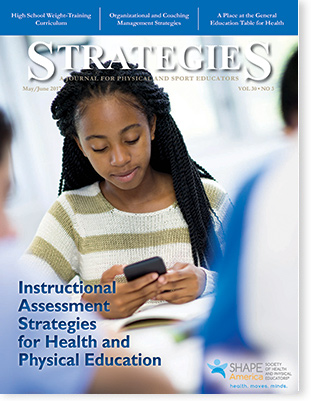 Strategies Table of Contents
Strategies Table of Contents
Instructional Assessment Strategies for Health and Physical Education
Phoebe Constantinou

Assessment has become increasingly important at all levels
in the education system (Broadfoot & Black, 2004; Guskey, 2011, 2013). Assessments
can be defined as the variety of methods used to grade, evaluate and rank
students’ knowledge or to measure everything from kindergarten readiness to potential college
success. Assessments are often perceived, particularly by students, as tests that mostly
express judgment of performance (Guskey, 2011; Kohn, 2011; Tomlinson, 2008). Earl
(2003) separated assessments into three areas: “assessments of learning,” which are assessments
that make a judgment on performance; “assessments for learning,” which are assessments
informing the teaching process (teacher); and “assessments as learning,” which are
assessments informing the learning process (student). Depending on where the emphasis is
placed when developing assessments, the impact of such assessments on teaching and learning
can be different (Tomlinson, 2008). This article discusses basic concepts of assessments
used in education and explores the idea of using “assessments for and as learning” — defined
as instructional assessments — in the field of health and physical education.
Defining Assessment
Concepts
Conventional or traditional assessments
Conventional assessments are quite popular among educators,
despite the controversy that such practices might not
be the best way to determine students’ knowledge. These assessments
are typically paper-and-pencil tests with multiple choice,
fill-in-the-blank, matching, and true-or-false questions.
Traditional assessments are seen as easy to administer and easy
to grade. Traditional tests could come along with a textbook
or be developed by the teacher. Typically, they require students
to select, recognize or recall content. Such assessments provide
very little to no opportunities for students to utilize higher order
thinking or problem-solving skills (Dietel, Herman, &
Knuth, 1991; Mauch, 2005). Generally, traditional assessments
are used as “assessments of learning” and are seen mostly as a
fair and objective way to judge students’ learning.
Authentic and performance-based assessments
These assessments can be defined as “assessments for learning”
and can easily become “assessments as learning.” These
assessments are more hands-on and are based on real-life
situations. When well designed, students are compelled to
evaluate, analyze and engage in problem solving and synthesize
solution(s). Thus, students engage in high-order thinking, while
utilizing prior knowledge and prior experiences to construct
their own new knowledge (Andrade, Huff, & Brooke, 2012).
In physical education, for example, asking students to develop
their own fitness program to increase muscular strength and
flexibility would require them to call on various concepts and
previous knowledge to complete the task. Similarly, in
health education, students may be asked to develop
a diet plan to decrease body fat. Authentic assessments
have the potential to provide direct
evidence of students’ learning while
guiding their learning in the process
(Dietel et al., 1991; Fusco &Barton, 2001).
To read the rest of this article,
click here to download a pdf.